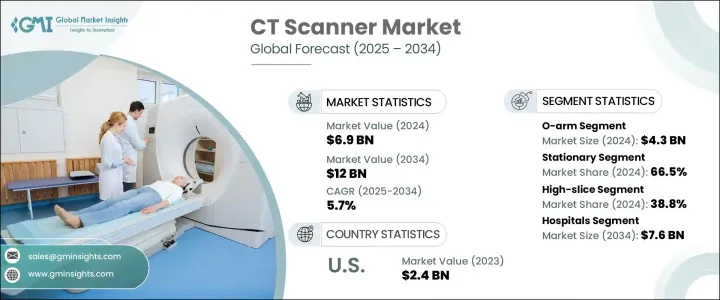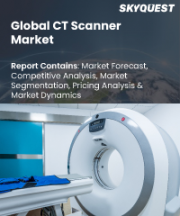
|
시장보고서
상품코드
1721529
CT 스캐너 시장 기회, 성장 촉진요인, 산업 동향 분석 및 예측(2025-2034년)CT Scanner Market Opportunity, Growth Drivers, Industry Trend Analysis, and Forecast 2025 - 2034 |
||||||
세계의 CT 스캐너 시장은 2024년 69억 달러로 평가되었고, CAGR 5.7%를 나타내 2034년에는 120억 달러에 달할 것으로 예측되고 있습니다. 신체의 고해상도 단면 영상을 제공함으로써 이러한 목표를 달성하는 데 있어 매우 중요한 역할을 하고 있습니다. 어떤 정확한 진단을 가능하게 하기 위해, 의료기관은 점점 이 시스템에 의지하게 되고 있습니다. 스캔 시간의 단축, 방사선 피폭의 저감, AI 및 머신러닝 알고리즘을 사용한 이미지의 선명도 향상을 목표로 하는 지속적인 혁신에 의해 더욱 지원되고 있습니다.

시장은 아키텍처별로 O암 시스템과 C암 시스템으로 구분되며, O암 부문은 2024년에 43억 달러를 창출했습니다. 이 부문은 2025년부터 2034년까지 5.6%의 연평균 성장률(CAGR)을 나타낼 것으로 예상됩니다. O 암 시스템은 수술실에서 직접 실시간 2D 및 3D 이미징 기능을 제공하여 수술 이미징을 변화시키고 있습니다. 처리실로 이송할 필요성을 최소화할 수 있습니다. 외과의사는 수술 중 가시성과 정밀도가 향상됨으로써 합병증의 위험을 줄이고 수술 결과의 개선으로 이어집니다.
| 시장 범위 | |
|---|---|
| 시작 연도 | 2024년 |
| 예측 연도 | 2025-2034년 |
| 시작 금액 | 69억 달러 |
| 예측 금액 | 120억 달러 |
| CAGR | 5.7% |
유형별로 시장은 휴대용 CT 스캐너와 거치형 CT 스캐너로 나뉘어져 있습니다. 반복 재구성, AI 탑재 진단 툴, 멀티 슬라이스 스캔 기능 등의 최근 진보로 거치형 CT 시스템의 진단 가치가 높아지고 있습니다.
북미의 CT 스캐너 시장은 2024년에 27억 달러로 평가되었으며, 2034년에는 46억 달러에 이를 것으로 예측됩니다. 훌라 및 연구 개발에 대한 왕성한 투자 특히 미국은 높은 건강 관리 지출과 주요 의료기기 제조업체의 존재감을 배경으로 첨단 이미지 솔루션을 통해 혁신을 이어가고 있습니다.
세계의 CT 스캐너 업계 유명 기업으로는 후지 필름 홀딩스, 어큐레이, 메드트로닉, 시마즈 제작소, Xoran Technologies, Koning Health, 캐논, GE HealthCare Technologies, PLANMED, CurveBeam AI, Samsung Electronics, 지멘스 헬티니즈, 뉴소프트 High-tech 등이 있습니다. 이러한 기업은 AI에 의한 기능 강화, 반복적 이미징 기술, 전략적 제휴에 다액의 투자를 실시해, 진단 능력의 향상과 세계의 사업 확대를 도모하고 있습니다.
목차
제1장 조사 방법과 범위
제2장 주요 요약
제3장 업계 인사이트
- 생태계 분석
- 업계에 미치는 영향요인
- 성장 촉진요인
- 세계적으로 만성질환의 유병률 증가
- 저침습 진단법에 대한 관심 증가
- CT 스캐너가 다른 영상 진단법에 제공하는 이점
- CT 스캐너에 있어서 기술의 진보
- 업계의 잠재적 위험 및 과제
- 많은 비용이 드는 설치와 유지 보수
- CT 스캔에 따른 위험
- 성장 촉진요인
- 성장 가능성 분석
- 기술의 상황
- 규제 상황
- 향후 시장 동향
- 갭 분석
- Porter's Five Forces 분석
- PESTEL 분석
제4장 경쟁 구도
- 서론
- 기업의 시장 점유율 분석
- 기업 매트릭스 분석
- 주요 시장 기업의 경쟁 분석
- 경쟁 포지셔닝 매트릭스
- 전략 대시보드
제5장 시장 추계·예측 : 아키텍처별(2021-2034년)
- 주요 동향
- O암
- C암
제6장 시장 추계·예측 : 유형별(2021-2034년)
- 주요 동향
- 휴대용
- 고정식
제7장 시장 추계·예측 : 기술별(2021-2034년)
- 주요 동향
- 하이 슬라이스
- 미드 슬라이스
- 로우 슬라이스
- 콘 빔
제8장 시장 추계·예측 : 용도별(2021-2034년)
- 주요 동향
- 인간
- 진단
- 신경학
- 종양학
- 심장학
- 기타
- 수술 중
- 진단
- 연구
- 수의사
제9장 시장 추계·예측 : 최종 용도별(2021-2034년)
- 주요 동향
- 병원
- CRO
- 외래수술센터(ASC)
제10장 시장 추계·예측 : 지역별(2021-2034년)
- 주요 동향
- 북미
- 미국
- 캐나다
- 유럽
- 독일
- 영국
- 프랑스
- 이탈리아
- 스페인
- 러시아
- 폴란드
- 오스트리아
- 스위스
- 슬로바키아
- 체코 공화국
- 노르웨이
- 핀란드
- 스웨덴
- 덴마크
- 베네룩스
- 아시아태평양
- 중국
- 일본
- 인도
- 한국
- 호주
- 대만
- 인도네시아
- 베트남
- 캄보디아
- 라틴아메리카
- 브라질
- 멕시코
- 중동 및 아프리카
- 사우디아라비아
- 남아프리카
- 아랍에미리트(UAE)
제11장 기업 프로파일
- Accuray
- Canon
- CurveBeam AI
- FUJIFILM Holdings Corporation
- GE HealthCare Technologies
- Koning Health
- Koninklijke Philips
- Medtronic
- Neusoft Medical Systems
- PLANMED
- Samsung Electronics
- Shenzhen Anke High-tech
- Shimadzu Corporation
- Siemens Healthineers
- Xoran Technologies
The Global CT Scanner Market was valued at USD 6.9 billion in 2024 and is expected to grow at a CAGR of 5.7% to reach USD 12 billion by 2034. The demand for advanced diagnostic imaging solutions continues to rise as healthcare providers prioritize early disease detection, precision medicine, and improved treatment outcomes. Computed Tomography (CT) scanners play a pivotal role in meeting these goals by delivering high-resolution, cross-sectional images of the human body. From routine screenings to emergency diagnostics, CT scanners have become a cornerstone of modern medical imaging. Healthcare institutions are increasingly relying on these systems to visualize complex internal structures, enabling accurate diagnoses for conditions such as cancer, cardiovascular diseases, internal injuries, and neurological disorders. As governments and private healthcare providers expand infrastructure and adopt digital health technologies, the CT scanner market is expected to witness consistent growth. This momentum is further supported by ongoing innovations that aim to reduce scanning times, lower radiation exposure, and enhance image clarity using AI and machine learning algorithms. With the healthcare industry leaning toward minimally invasive procedures and patient-centric care, the adoption of CT imaging continues to grow at a significant pace.

The market is segmented by architecture into O-arm and C-arm systems, with the O-arm segment generating USD 4.3 billion in 2024. This segment is projected to grow at a CAGR of 5.6% between 2025 and 2034. O-arm systems are transforming the surgical imaging landscape by offering real-time 2D and 3D imaging capabilities directly in operating rooms. Their compact and mobile design enables seamless integration into surgical workflows, minimizing the need to transport patients to dedicated imaging suites. Surgeons benefit from enhanced visibility and accuracy during procedures, which reduces the risk of complications and leads to better surgical outcomes. The growing demand for intraoperative imaging and precision-guided surgeries is expected to drive sustained growth in this segment over the forecast period.
| Market Scope | |
|---|---|
| Start Year | 2024 |
| Forecast Year | 2025-2034 |
| Start Value | $6.9 Billion |
| Forecast Value | $12 Billion |
| CAGR | 5.7% |
In terms of type, the market is divided into portable and stationary CT scanners. The stationary segment dominated in 2024, generating USD 4.6 billion and accounting for a 66.5% market share. These systems are known for their superior image resolution, high-speed scanning, and robust performance in high-volume healthcare settings. Recent advancements such as iterative reconstruction, AI-powered diagnostic tools, and multi-slice scanning capabilities have elevated the diagnostic value of stationary CT systems. They remain the preferred choice for hospitals and diagnostic centers seeking consistent, high-quality imaging across a wide range of medical applications.
The North America CT Scanner Market was valued at USD 2.7 billion in 2024 and is forecasted to reach USD 4.6 billion by 2034. The region's market expansion is driven by the rising incidence of chronic diseases, along with strong investments in diagnostic infrastructure and R&D. The U.S., in particular, continues to lead innovation through advanced imaging solutions fueled by high healthcare expenditure and a strong presence of leading medical device manufacturers.
Some of the prominent players in the global CT scanner industry include FUJIFILM Holdings Corporation, Accuray, Medtronic, Shimadzu Corporation, Xoran Technologies, Koning Health, Canon, GE HealthCare Technologies, PLANMED, CurveBeam AI, Samsung Electronics, Siemens Healthineers, Neusoft Medical Systems, Koninklijke Philips, and Shenzhen Anke High-tech. These companies are heavily investing in AI-driven enhancements, iterative imaging technologies, and strategic collaborations to elevate diagnostic capabilities and expand their global footprint.
Table of Contents
Chapter 1 Methodology and Scope
- 1.1 Market scope and definitions
- 1.2 Research design
- 1.2.1 Research approach
- 1.2.2 Data collection methods
- 1.3 Base estimates and calculations
- 1.3.1 Base year calculation
- 1.3.2 Key trends for market estimation
- 1.4 Forecast model
- 1.5 Primary research and validation
- 1.5.1 Primary sources
- 1.5.2 Data mining sources
Chapter 2 Executive Summary
- 2.1 Industry 3600 synopsis
Chapter 3 Industry Insights
- 3.1 Industry ecosystem analysis
- 3.2 Industry impact forces
- 3.2.1 Growth drivers
- 3.2.1.1 Increasing prevalence of chronic diseases worldwide
- 3.2.1.2 Rising preference for minimally invasive diagnostic procedures
- 3.2.1.3 Advantages offered by CT scanner over other imaging modalities
- 3.2.1.4 Technological advancements in CT scanner
- 3.2.2 Industry pitfalls and challenges
- 3.2.2.1 Significant installation and maintenance cost
- 3.2.2.2 Risks associated with CT scan
- 3.2.1 Growth drivers
- 3.3 Growth potential analysis
- 3.4 Technology landscape
- 3.5 Regulatory landscape
- 3.6 Future market trends
- 3.7 Gap analysis
- 3.8 Porter’s analysis
- 3.9 PESTEL analysis
Chapter 4 Competitive Landscape, 2024
- 4.1 Introduction
- 4.2 Company market share analysis
- 4.3 Company matrix analysis
- 4.4 Competitive analysis of major market players
- 4.5 Competitive positioning matrix
- 4.6 Strategy dashboard
Chapter 5 Market Estimates and Forecast, By Architecture, 2021 – 2034 ($ Mn)
- 5.1 Key trends
- 5.2 O-arm
- 5.3 C-arm
Chapter 6 Market Estimates and Forecast, By Type, 2021 – 2034 ($ Mn)
- 6.1 Key trends
- 6.2 Portable
- 6.3 Stationary
Chapter 7 Market Estimates and Forecast, By Technology, 2021 – 2034 ($ Mn)
- 7.1 Key trends
- 7.2 High-slice
- 7.3 Mid-slice
- 7.4 Low-slice
- 7.5 Cone beam
Chapter 8 Market Estimates and Forecast, By Application, 2021 – 2034 ($ Mn)
- 8.1 Key trends
- 8.2 Human
- 8.2.1 Diagnostic
- 8.2.1.1 Neurology
- 8.2.1.2 Oncology
- 8.2.1.3 Cardiology
- 8.2.1.4 Others
- 8.2.2 Intraoperative
- 8.2.1 Diagnostic
- 8.3 Research
- 8.4 Veterinary
Chapter 9 Market Estimates and Forecast, By End Use, 2021 – 2034 ($ Mn)
- 9.1 Key trends
- 9.2 Hospitals
- 9.3 CROs
- 9.4 Ambulatory surgical centers
Chapter 10 Market Estimates and Forecast, By Region, 2021 – 2034 ($ Mn)
- 10.1 Key trends
- 10.2 North America
- 10.2.1 U.S.
- 10.2.2 Canada
- 10.3 Europe
- 10.3.1 Germany
- 10.3.2 UK
- 10.3.3 France
- 10.3.4 Italy
- 10.3.5 Spain
- 10.3.6 Russia
- 10.3.7 Poland
- 10.3.8 Austria
- 10.3.9 Switzerland
- 10.3.10 Slovakia
- 10.3.11 Czech Republic
- 10.3.12 Norway
- 10.3.13 Finland
- 10.3.14 Sweden
- 10.3.15 Denmark
- 10.3.16 Benelux
- 10.4 Asia Pacific
- 10.4.1 China
- 10.4.2 Japan
- 10.4.3 India
- 10.4.4 South Korea
- 10.4.5 Australia
- 10.4.6 Taiwan
- 10.4.7 Indonesia
- 10.4.8 Vietnam
- 10.4.9 Cambodia
- 10.5 Latin America
- 10.5.1 Brazil
- 10.5.2 Mexico
- 10.6 Middle East and Africa
- 10.6.1 Saudi Arabia
- 10.6.2 South Africa
- 10.6.3 UAE
Chapter 11 Company Profiles
- 11.1 Accuray
- 11.2 Canon
- 11.3 CurveBeam AI
- 11.4 FUJIFILM Holdings Corporation
- 11.5 GE HealthCare Technologies
- 11.6 Koning Health
- 11.7 Koninklijke Philips
- 11.8 Medtronic
- 11.9 Neusoft Medical Systems
- 11.10 PLANMED
- 11.11 Samsung Electronics
- 11.12 Shenzhen Anke High-tech
- 11.13 Shimadzu Corporation
- 11.14 Siemens Healthineers
- 11.15 Xoran Technologies



















